“Robin Sutherland is an emerging arts manager and community artist who has recently moved from Toronto to her home community of Algoma, Northern Ontario, to establish Thinking Rock Community Arts, a new organization that will seek to engage and build community along the North Shore of Lake Huron. This blog will follow her journey along that path.
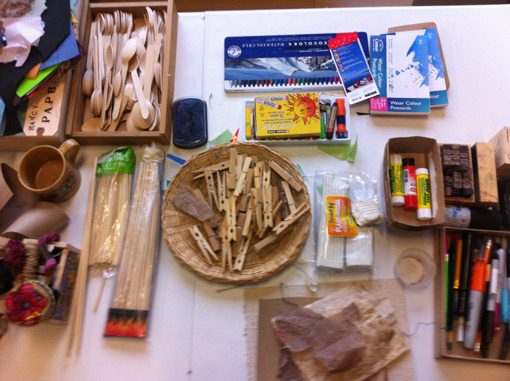
A table full of creative tools
The Oral History and Art-Making Workshop, put on by Jumblies Theatre February 20-23 2013, began as any good workshop does – with tea and coffee, healthful snacks and gracious, welcoming hosts. As one participant said, « you can tell how supportive an environment is in the first eleven seconds you walk in the room », and this environment was very supportive from the outset.
Fifteen participants were welcomed in this way into the Toronto Fringe Festival’s rehearsal space at CSI Annex, a bright and airy space overlooking Bathurst Street in Toronto. We were given various printed resources, as well as a small notebook we could decorate using the provided art supplies. This small creative task allowed us some informal time to connect and chat with one another.
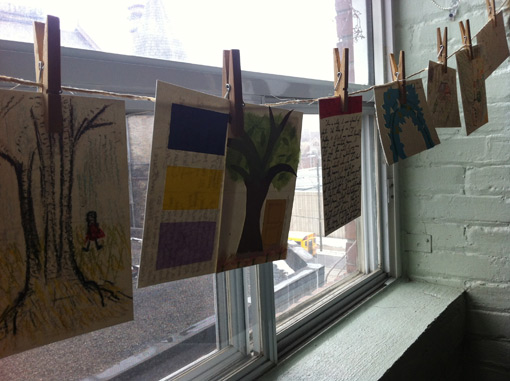
My group’s activity: write a postcard to your childhood home
To open the workshop, our first exercise was to write down a question we would like to be asked. We were then told to turn around and ask that question of the person next to us. It was interesting to see how many people felt that the question their interviewer put to them was exactly the question they had wanted to be asked, or that it resonated with them in an unexpected way.
This would become a common theme throughout the workshop: recognizing that although we each carry different stories, we also share common experiences, and so can all relate to one another’s stories on some level. This fun, simple task also provided immediate insight into the magic that is held within each of our stories, and that what might seem trivial to us can in fact be inspiring to others.
As the workshop progressed, we learned many practical and technical skills related to interviewing. For example, you should always wear headphones when recording, and you should record a moment of the silence of the space before interviewing – this can be used in editing the audio later. We learned that you shouldn’t be afraid to hold the audio recording equipment close to someone’s mouth – as awkward as it might feel, it’s necessary, and they will quickly learn to ignore it.
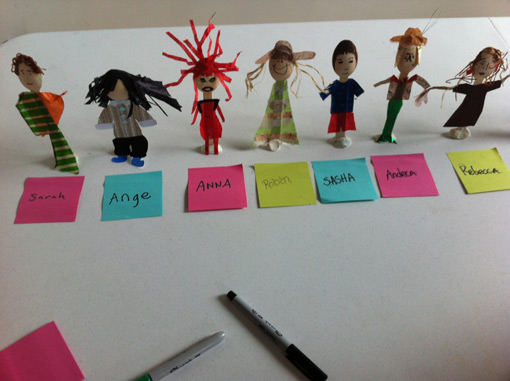
Our spoon people – later we danced a jig with them
We also learned techniques and tips about how to make the interviewee comfortable, how to listen and ask appropriate questions, and how to hold ourselves back from making interjections – such as sighs, gasps, or sounds of agreement – as much as possible, so we would be able to use the audio recording later on. We learned to not be afraid of silence, and to not overreact or under-react when being told shocking or traumatic stories; that it is often best to just listen, and show empathy through body language, as opposed to projecting our own reaction onto someone else’s experience. We learned that in order to downplay the potential for intimidation in interviews, it can help to lead with a simple question unrelated to the topic you’re looking to explore. This will often provide a natural transition into the topic at hand, as opposed to jumping right into the subject – especially if it is a traumatic or painful topic.
At one point in the workshop we collectively created a long list of disciplines that could be used to creatively represent stories. These ranged from puppetry and poetry to music and myth, dance and theatre to soundscapes and collage. Other suggestions included geocaching stories; setting a table or creating a meal using stories; making a quilt or other fabric project with stories interwoven throughout it; creating a board game; planning an audio walk; creating public art, pageants and parades; writing a novel; creating sacred spaces for people to explore their own stories; live sculpting; live painting – the list goes on. We also learned that there are different options for incorporating the original story; you could use the original audio in a performance, repeat parts of the recording verbatim, or even choose to leave the original audio behind and take from it only the main themes or images that stand out most and incorporate those into the work.
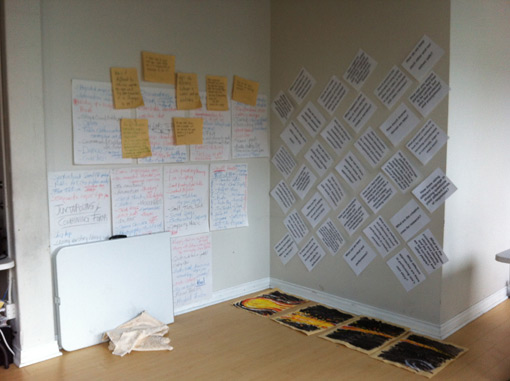
The writing is on the wall: brainstorming and questions
Following this task, close to the end of the workshop we had the opportunity to interview each other and then represent these stories through mini performances using some of the disciplines we had collectively named. I found this to be an unexpectedly difficult task, which drove home the sense of responsibility and accountability we as artists have to the stories we represent. We were dealing with memories which, even if happy, remind us of an emotional state that has long been forgotten. When someone takes those memories, distills them to their essence, and represents them using an artistic form, it can be one of the most powerful, validating, and beautifully heart-wrenching experiences imaginable.
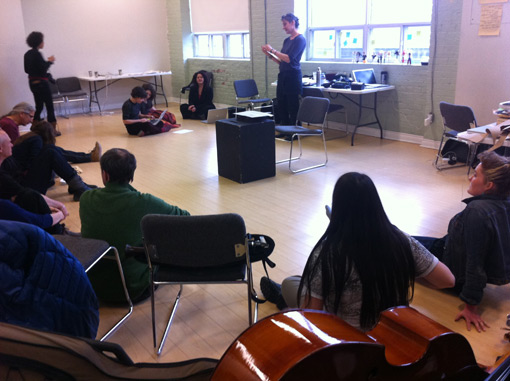
Preparing to perform our pieces based on each other’s stories
Overall, what I took away from the Oral History and Art-Making workshop was a deep appreciation for the possibilities and the importance of working with peoples’ personal stories. I learned that oral history is inherently relational, as it requires both a teller and a listener. There is great responsibility placed on one who draws out and represents the story of another; this act must be taken seriously, and treated with respect. At the same time, once a story is passed to another it becomes more than personal; what was your story is now everyone’s story. Although this sounds terrifying, it can be an incredibly joyful and cathartic act of letting go – handing your lived experience over to another and giving them permission to do what they will with it can be very freeing. And, as the artists who receive these stories, we are then tasked with not only doing justice to the stories we are handed, but with bringing even more life to them in the retelling.
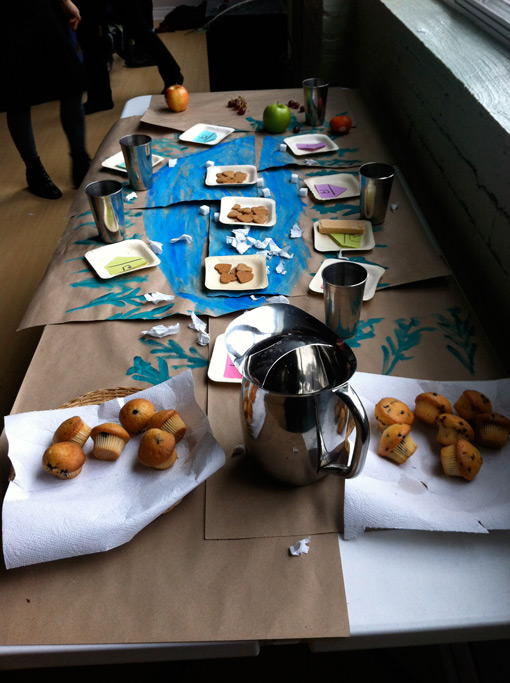
My story, beautifully represented using a table and food
This workshop was made possible thanks to funding from the Canada Council for the Arts (Interarts), the J.W. McConnell Foundation and operating support from the Toronto and Ontario Arts Councils. Robin Sutherland took part in the project thanks to the Theatre Ontario Professional Theatre Training Program, funded by the Ontario Arts Council. »
– Robin Sutherland, Founder and Artistic Director, Thinking Rock Community Arts
All photos courtesy of Robin Sutherland
robin.a.sutherland@gmail.com
Previous posts from Robin:
05/03/13 – Inspiration and Trepidation: Starting a Community Arts Organization « Where It Started » (Algoma, ON)
04/05/13 – Inspiration and Trepidation: Starting a Community Arts Organization (Algoma, ON)
01/16/13 – Thesis: Community Arts and Social Change in Rural Northern Ontario
For ArtBridges/ToileDesArts sponsorship opportunities: Simon Constam, Sponsorship Director, simon@artbridges.ca, 905-537-7227
Return to ArtBridges/ToileDesArts homepage
